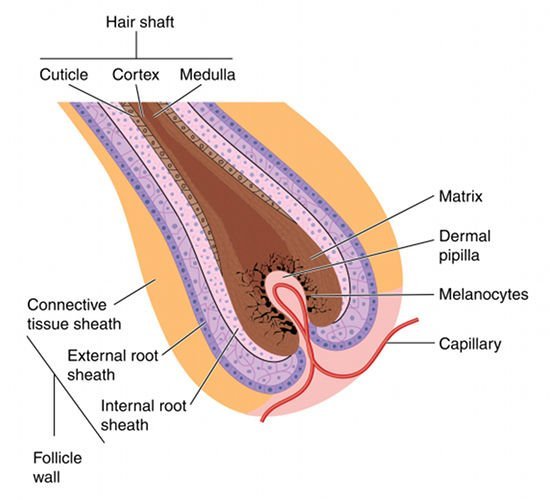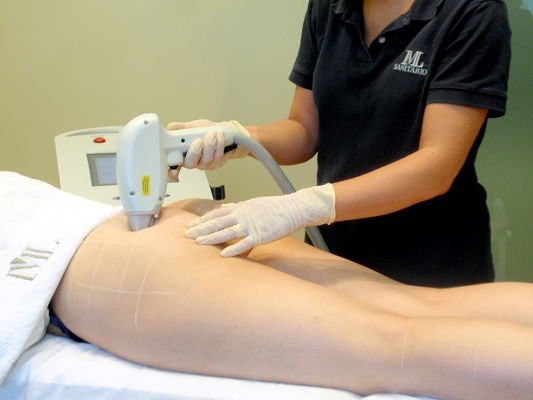12th CONGRESS OF THE SPANISH SOCIETY OF MEDICAL-SURGICAL LASER
Dr. Royo de la Torre
The basic purpose of the treatment is to irreversibly damage the "cells that generate hair". The publication of the results of the studies performed by Rebecca J. Morris et al. in Nature Biotechnology 22,411-417 have allowed us to determine the genetic profile of Stem Cells in the Hair Follicle. These studies showed the existence of several receptors that represent potential tools to treat hair loss and other hair and skin disorders.
It was accepted that the natural growth cycle of hair was dependent on the Stems Cells contained in the Hair Follicle. This study evidenced that these cells give rise to all epithelial elements of the new hair follicle during its normal cycle, showing that these cells are the progenitor cells of the whole follicular epithelium.
Therefore, we can conclude, in line with other authors, that:
Follicular stem cells do not have a significant amount of pigment. We must reach a sufficient level of thermal damage in a target that is not uniformly pigmented by transmitting diffuse heat from the “heater” (absorbing pigmented area).

To achieve permanent hair removal it is necessary to damage stem cells in the bulge area
1. Selection of the laser wavelength will depend on the maximum absorption coefficient of the pigmented area, in contrast with the absorption coefficient of the tissue surrounding the target. Wavelengths within the optical window will be used, where wavelengths have a maximum absorption coefficient by melanin of: 650 -1200 nm.
2. Pulse length must be equal to or below the “thermal damage time of the target” (time in which the most external part of the target reaches an adequate temperature to damage the lesion) and this time can be considerably longer that the “thermal relaxation time of the target”.
We must take into account “the thermal relaxation time of the heater”, plus the time required by heat to diffuse from the hair shaft (heater) to the most external part of the hair follicle, which is where the target is located.
Because of this, the TDT for a target other than the heater is TDT>TRT. This justifies the contrasted efficacy of a long pulse, delivering more energy at each pulse, as the epidermis is more protected, resulting in less discomfort during the session.
The Extended Theory of Selective Photothermolysis calculates the ideal wavelength for a “target” at a distance from the “heater”, considering the heat diffusion time from the “heater” to the most external part of the “target”.
Is the irreversible thermal damage time for the most external part of the target.
As a rule, available systems do not usually provide such a high wavelength; some have been updated, such as Light Sheer Diode, which emits 400 ms. In general, we try to work with systems that emit longer pulses (body laser hair removal) at high fluences and use short pulse lasers (gentle 3 ms Candela Gentle Laser) in residual miniaturised fine hair.
This explains why there was no improvement in the results, such as in the male’s back at high fluence with short pulses, probably due to the release of substances resulting from the direct combustion of hair (with release of steam from water, ruptured chromophore or bubbles) that break the interface and hinder the transmission of heat to the “target” from the “heater”.
For a pulse significantly shorter than 30 ms, at equal fluence, there is more hair combustion and release of products from the ablation of the hair follicle. In this case, damage to the hair follicle would decrease alongside the decrease in pulse length, and for very short pulses, damage could be limited to the hair shaft.
The differences between theory and practice for pulses over a 400 ms length can be explained by the scant irradiation capacity of currently available systems, which are incapable of delivering 100W/cm2, which is required to raise the heater temperature to nearly 100 °C.
For a fluence of 35 joules/cm2, with 800 nm diode laser and 9 x 9 mm spot size, Irradiation, which is Fluence/Time, is as follows:
3. With respect to fluence.
Energy must be limited to prevent loss of heat absorption in the pigmented area (100 °C), but must be high enough to heat the area above an effective temperature that will cause thermal damage in the target.
In case the heater reaches a temperature higher than it can absorb, direct ablation of the heater will occur, with release of combustion substances that can hinder clean heat diffusion towards the target.
4. Interval between sessions:
Given that stem cells in the hair follicle survive past the telogen phase in the bulge, the interval between sessions does not necessarily have to follow hair growth phases. Whenever there is a hair shaft, we can heat the bulge and achieve permanent hair removal. This has been observed by many authors.
We published a study showing that in one high efficacy session, we could remove a higher percentage of hair in total than the theoretical total figure in the anagen phase in hair in the female armpit. We propose maintaining an interval between sessions so there is sufficient hair density and suggest using a razor blade using these breaks.

IML hair removal session with diode laser
It is highly advisable to establish the patient's expectations of achieving permanent hair removal, depending on the area to be treated. Therefore, we need to take into account those body areas that carry primordial hair follicles that can or cannot become activated over time (androgen-dependent areas) and, that are potentially capable of growing new hair after thorough laser hair removal.
This is the case of facial hair in women and other areas that are hormone-dependent such as areolae, cleavage, linea alba and lumbar region. In men, hair growth on the back and trunk starts in adolescence and does not stop until maturity is reached; the testosterone concentration in a 55-year-old male is 15% of that of a 25-year-old.
As a consequence, this influences the cessation of the stimulation for the development of body hair. Men start to show hair growth in the tragus after the age of 40 and it does not stop appearing, in increasing amounts for the rest of their lives.
We need to explain to patients that in these cases, laser does not fail, but it can only eliminate the hairs that are present at the time of the session and further treatment will be necessary for subsequent hair growth.
And, logically, any patient whose wish is to eliminate very finely pigmented or fine hair, should be advised against it.
Some studies relating to photodynamic therapies using photosensitive agents at a spectrum of 630-635 nm, Dierixcks 2002, have been published. Systems have been developed that combine the emission of Radiofrequency and Laser. These systems aim to optimise the results in treatment of mildly pigmented and small calibre hair follicles.
Basically, the objective is to manage skin impedance. Impedance is the inverse function of conductivity and also provides information on tissue temperature, as temperature changes modify impedance, by measuring the temperature we will determine impedance.
The system that we have been using at IML is the Aurora system, from Syneron. This system is equipped with an external impedance sensor that determines the temperature of the skin surface. Through the emission of a non-coherent light beam, the objective is to heat the hair follicles, accepting that the temperature reached does not cause thermal damage.
Nevertheless, such relative increase in temperature does modify follicle impedance, resulting in increased flow of radiofrequency that is delivered by the system following the light emission. Measurement of impedance on the skin surface determines the level of safety of the system, since skin heating would decrease impedance, which in turn would be detected by the system.
The increase in flow density of radiofrequency waves would cause the necessary damage. This methodology is rather attractive. We have tried the Aurora laser from Syneron for several months in hundreds of patient and although it has shown to be a good system, we have observed no advantages in “impossible hair” and works as the rest of systems in standard indication hair. The route of complementary technologies to lasers is open and it is almost certain that new optimised prototypes will appear in the next few years.
The future awaits with technological and scientific improvements, which we hope to be able to continue to share with our colleagues at the Spanish Society of Medical-Surgical Laser.
Would you like more information about laser hair removal? Contact Instituto Medico Laser now.